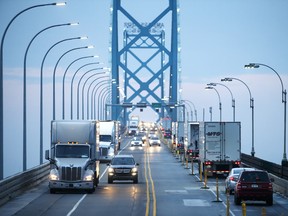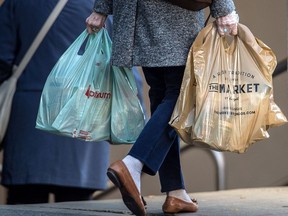But the Canadian currency could start appreciating soon
Article content
An unexpected perk of the pandemic is Canada recording its first current account surpluses in about 13 years, but the milestone hasn’t been transformative for the Canadian dollar.
Advertisement
This advertisement has not loaded yet, but your article continues below.
Article content
The surplus doubled to $3.6 billion during the second quarter from $1.8 billion in the year’s first three months, according to Statistics Canada. Yet the strength of the domestic economy hasn’t been echoed in the performance of the loonie.
The last time Canada’s finances were this in the black, in 2008, the currency traded at par with the greenback. Now it’s about 20 cents shy.
The reason is travel, or rather the lack of it.
During normal times, Canadians travel abroad and spend more money than tourists spend here. That lowers the current account surplus until it’s usually a deficit. Now, the American land border is still closed and other countries are just getting their rules in place about who they’re going to let in and when.
Advertisement
This advertisement has not loaded yet, but your article continues below.
Article content
“In our view, it has to do with the temporary nature of the surplus…. As things normalize, we can expect the travel account to return to a deficit,” Stéfane Marion, chief economist and strategist at National Bank of Canada, says in a research note.
“A return to pre-crisis levels could reduce the current account surplus by as much as $4 billion to $5 billion. The Canadian dollar may be undervalued now, but not by as much as the current account balance suggests.”

A rebound in commodity prices during the second quarter since the worst days of the pandemic also helped drive the surplus, Statistics Canada said. There were higher prices for exported lumber, oil, and materials for buildings and packaging. This was partially offset by lower auto exports because of the global shortage in semiconductor chips.
Advertisement
This advertisement has not loaded yet, but your article continues below.
Article content
Other factors may have been in play during the pandemic to create the current account surpluses, such as lower domestic demand during lockdowns, while foreign supply constraints limited imports.
Recent knocks on commodity prices and the expected rise in travel as pandemic restrictions are lifted over the next months will likely send the current account back into deficit territory, CIBC Capital Markets said in its own research note.
The continued spread of the Delta variant in the U.S. just as the U.S. Federal Reserve indicates it could taper stimulus this year are also weighing on commodity prices. Still, Canada’s relatively high inoculation rate could bode well for its economic growth, and its currency.
Advertisement
This advertisement has not loaded yet, but your article continues below.
Article content
The loonie hit a six-month low Aug. 22 when it was measured at $1.28 to buy one greenback. It had improved to $1.26 Wednesday. National Bank said it could reach $1.22 in the coming months, in line with an early-August poll of analysts by Reuters.
The Fed’s plan to taper stimulus means buying fewer bonds to inject capital into the market. Fewer U.S. dollars in the market will increase their value, and the value of U.S. government bond yields, heightening the attraction for investors of assets traded in U.S. dollars, which could limit the loonie’s appreciation.
National Bank economists say the federal elections won’t change their forecast for the loonie, given that all the federal parties have announced more fiscal spending to influence voters.
Advertisement
This advertisement has not loaded yet, but your article continues below.
Article content
There has been little-to-no premium priced into the Canadian dollar — relative to the greenback — due to the the last five federal elections, Bipan Rai, the head of foreign-exchange strategy at CIBC, wrote in a note to clients. He said most movements in the Canadian dollar can be attributed to other factors — such as oil prices, bond yields and the strength of the U.S. dollar — and the elections on Sept. 20 are unlikely to be much different.

Scotiabank economist rips Statistics Canada for dropping election GDP ‘bomb’

‘A longer road to recovery:’ Canada’s economy shrinks, catching economists by surprise

Businesses to raise prices as party leaders contend with rising cost of living

Tiff Macklem’s dashboard: Charting economy’s exit from pandemic puzzle
Advertisement
This advertisement has not loaded yet, but your article continues below.
Article content
“This election is unlikely to mean much for the CAD. In fact, most election campaigns in Canada don’t really end moving the dial for the loonie at all,” Rai wrote. “The country’s risk/return profile is still far too attractive to foreign investors and this election won’t change any of that.”
Yet investors are still pricing in a small amount of uncertainty. Three-week implied volatility in the loonie-U.S. dollar exchange rate, a tenor that extends one day past the vote, is priced at 7.2 per cent, or 0.3 per cent percentage points higher than the three-month volatility of 6.9 per cent.
With additional reporting from Bloomberg
Financial Post
Listen to Down to Business for in-depth discussions and insights into the latest in Canadian business, available wherever you get your podcasts. Check out the latest episode below:
Advertisement
This advertisement has not loaded yet, but your article continues below.
The loonie was at par with the U.S. dollar last time Canada’s trade surplus was so robust. What’s so different now?
2021-09-01 16:30:16






